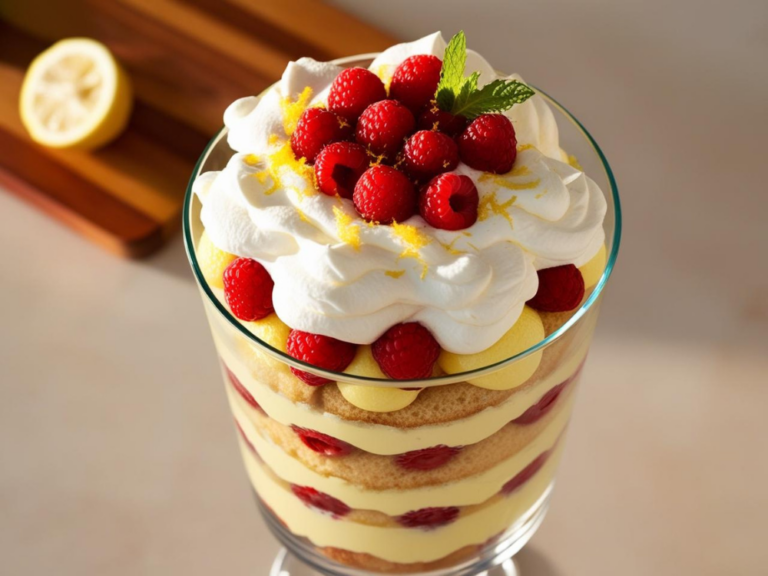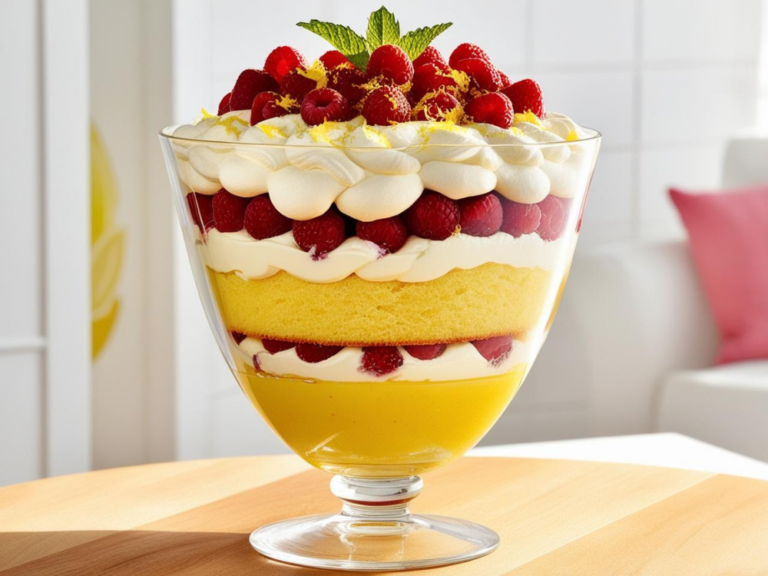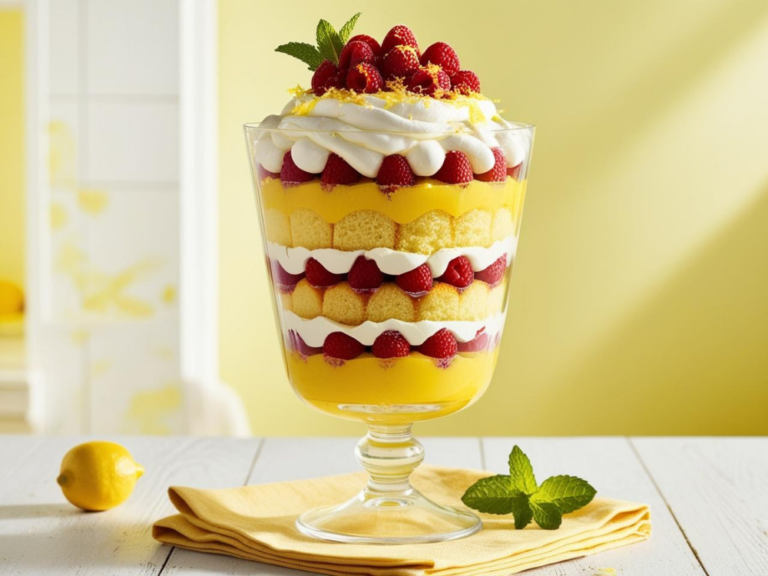Lemon Raspberry Trifle

A Perfectly Sweet & Tangy Dessert
Looking for a dessert that’s not only stunning to look at but also irresistibly delicious? This Lemon Raspberry Trifle is the ultimate crowd-pleaser, perfect for any occasion. With its vibrant layers of zesty lemon custard, fresh raspberries, fluffy whipped cream, and soft sponge cake, this dessert strikes the perfect balance of sweet and tangy. Whether you’re hosting a summer gathering, planning a brunch, or just want a simple yet impressive treat, this trifle has you covered.
What makes this Lemon Raspberry Trifle even better is how easy it is to make. There’s no baking involved, and it comes together in no time! It’s a versatile dessert that can be made ahead of time, making it stress-free for entertaining. Plus, the bright colors and refreshing flavors are guaranteed to make it a star on your dessert table. Get ready to wow your family and friends with this simple, elegant, and oh-so-delicious recipe!

Nutritional Information: What’s Inside This Lemon Raspberry Trifle?
If you’re curious about what’s in your dessert, let’s break down the nutritional value of this Lemon Raspberry Trifle. While trifles are known for their indulgent flavors, they can also be a balanced treat when enjoyed in moderation. Here’s an overview of what you’re savoring in each layer.
Calories
A single serving of Lemon Raspberry Trifle (based on 8 servings in a standard-sized trifle dish) typically ranges between 250 to 350 calories, depending on the ingredients you use. The whipped cream and sponge cake contribute most to the calorie count, while the raspberries and lemon custard provide a lighter, fruit-forward balance.
Carbohydrates
The sponge cake and custard are the primary sources of carbohydrates in this dessert, providing about 30-40 grams per serving. These carbs give you a quick energy boost, making the trifle an ideal dessert for gatherings where you need to stay lively!
Protein
This trifle isn’t particularly high in protein, offering around 4-6 grams per serving, mostly from the whipped cream and any eggs used in the custard. For a boost, you could use a protein-enriched custard or incorporate a Greek yogurt layer.
Fat
The whipped cream is the main contributor to the fat content, which is typically around 10-15 grams per serving, depending on whether you use heavy cream or a lighter alternative. To cut down on fat, consider using a low-fat whipped topping or coconut whipped cream.
Fiber
Raspberries are a great source of dietary fiber, adding about 3-4 grams per serving to this dessert. Fiber not only supports digestion but also helps balance the sweetness of the trifle with a bit of natural goodness.
Sugars
The sugar content is one of the highlights of this dessert, with about 20-30 grams of sugar per serving. This includes natural sugars from the raspberries and added sugars in the custard, sponge cake, and whipped cream. To reduce sugar, you can opt for a sugar-free custard mix and a naturally sweetened cake.
Vitamins and Minerals
This trifle isn’t just a treat for your taste buds—it also offers some nutritional benefits:
- Vitamin C: Raspberries and lemon custard are rich in Vitamin C, helping to support your immune system and overall health.
- Calcium: If you use dairy-based custard or whipped cream, you’ll get a small boost of calcium for stronger bones and teeth.
- Antioxidants: Raspberries are loaded with antioxidants, which help fight free radicals and promote overall well-being.
Customizing for Dietary Needs
If you have specific dietary requirements, you can make this trifle work for you:
- For a lower calorie version, use a light sponge cake, sugar-free custard, and low-fat whipped cream.
- To make it gluten-free, swap the sponge cake with a gluten-free alternative.
- For a dairy-free trifle, use almond or oat milk for the custard and coconut whipped cream.
Balance and Moderation
While this dessert is on the indulgent side, its fresh raspberries and zesty lemon flavors bring a lightness that makes it feel less heavy. Pairing it with a meal rich in proteins and healthy fats can help balance the overall nutritional profile of your day.
In the end, this Lemon Raspberry Trifle isn’t just a sweet treat—it’s a dessert with a little something for everyone. Whether you’re savoring a small portion or customizing it to suit your needs, it’s a delightful way to enjoy a vibrant and flavorful finish to your meal.

Healthier Options for Your Lemon Raspberry Trifle
Who says dessert can’t be delicious and healthy? With a few thoughtful tweaks, you can enjoy this Lemon Raspberry Trifle guilt-free while still savoring its tangy, sweet, and creamy goodness. Here are some ideas to make your trifle lighter, healthier, and perfect for those watching their calorie intake or trying to incorporate more wholesome ingredients.
1. Swap Out the Sponge Cake
The sponge cake in a traditional trifle is often a source of refined carbs and added sugar. Here’s how you can lighten it up:
- Use Angel Food Cake: This cake is naturally low in fat and calories, making it a great alternative.
- Try Whole-Grain Options: Bake or buy a sponge cake made with whole-wheat flour for added fiber and nutrients.
- Opt for Gluten-Free Alternatives: Use almond flour or oat-based cakes to make it gluten-free and protein-rich.
2. Lighten the Custard
Custard is creamy and indulgent but often loaded with heavy cream and sugar. Here’s how to keep the flavor without the guilt:
- Use Low-Fat or Skim Milk: Substitute whole milk or cream with skim milk or unsweetened almond milk to reduce fat content.
- Sweeten Naturally: Replace sugar with natural sweeteners like honey, maple syrup, or stevia.
- Greek Yogurt Custard: For a creamy yet healthy twist, mix Greek yogurt with lemon zest and a bit of honey or stevia for sweetness.
3. Whipped Cream Alternatives
Whipped cream is one of the richest components of the trifle. Try these options to lighten it up:
- Coconut Whipped Cream: Made from chilled coconut milk, this is a dairy-free, lighter option.
- Light Whipped Topping: Use a reduced-fat or calorie version of whipped topping.
- Greek Yogurt Layer: Add a tangy layer of Greek yogurt instead of whipped cream for added protein and a creamy texture.
4. Rethink the Sweeteners
Reducing or replacing refined sugar can have a significant impact:
- Stevia or Monk Fruit: Both are natural, calorie-free sweeteners that blend well into desserts.
- Honey or Maple Syrup: These natural sweeteners offer a touch of flavor along with their sweetness.
- Fresh Fruit as Sweetener: The natural sugars in raspberries and other fresh fruits can help you cut back on added sugars.
5. Boost the Nutritional Value
Why not sneak in some extra nutrients while you’re at it?
- Add Chia Seeds: Layer some chia seeds between the custard and whipped cream for extra fiber and omega-3s.
- Incorporate Nuts: Crushed almonds, pistachios, or walnuts can add crunch and healthy fats.
- Layer More Fruits: Add blueberries, strawberries, or sliced kiwi for a colorful and nutrient-packed dessert.
6. Go Sugar-Free
For a diabetic-friendly or low-sugar version, you can:
- Use Sugar-Free Custard: Many custard recipes can be made sugar-free with sweetener alternatives.
- Pick Sugar-Free Whipped Topping: Look for low-carb or sugar-free whipped toppings at your local grocery store.
- Choose Naturally Sweet Raspberries: Ripe raspberries are naturally sweet, so you might not need to add as much sugar overall.
7. Portion Control
Sometimes, the key to a healthier dessert is simply enjoying it in smaller portions.
- Individual Servings: Serve the trifle in small glasses or jars to make portion control easy and visually appealing.
- Mini Trifles: Make bite-sized trifles in shot glasses for a fun, calorie-conscious option.
8. Skip the Alcohol
If you usually soak the sponge cake in a liqueur, consider these alternatives:
- Freshly Squeezed Orange Juice: Adds a tangy flavor without the extra calories from alcohol.
- Unsweetened Tea: A light herbal tea like chamomile or lemon works beautifully as a non-alcoholic soaking liquid.
9. Make It Dairy-Free
For those avoiding dairy, you can still create a luscious Lemon Raspberry Trifle:
- Plant-Based Milk: Use almond, oat, or coconut milk for the custard.
- Dairy-Free Whipped Cream: Opt for a coconut-based or soy-based whipped cream.
- Dairy-Free Cake: Choose a vegan cake recipe or one made with dairy-free ingredients.
10. Add More Raspberries
Since raspberries are naturally low in calories and high in fiber, they’re a fantastic way to fill out the trifle while adding a burst of natural sweetness and color.
Balance and Flavor First
Remember, making healthier choices doesn’t mean compromising on taste. By incorporating these options, you can enjoy a lighter Lemon Raspberry Trifle that’s just as satisfying as the original. Whether you’re swapping out the cake, lightening up the cream, or cutting back on sugar, there’s a way to customize this dessert for any diet or preference while keeping it as vibrant and delicious as ever!
Try some of our other recipes!
Portion Adjustments: Making the Lemon Raspberry Trifle Fit Every Occasion
One of the best things about a Lemon Raspberry Trifle is how versatile it is. Whether you’re serving a crowd at a big event or just treating yourself to a single portion, adjusting the recipe to fit your needs is simple and straightforward. Here’s how you can make portion adjustments to ensure everyone gets their share—without overindulging or wasting food.
1. Single-Serving Trifles
Perfect for when you want a personal indulgence or an elegant individual dessert for your guests.
- Glassware Ideas: Use mason jars, stemless wine glasses, or dessert cups to create personal portions. These make the presentation just as appealing as the full-sized trifle.
- Layering Tips: With smaller portions, it’s easier to keep the layers clean and distinct. Use piping bags for the custard and whipped cream to maintain precision.
- Why It Works: Individual servings not only control portion sizes but also make it easy for guests to grab their own without waiting for the dessert to be served.
2. Mini Trifles for Parties
Hosting a party or a large gathering? Mini trifles are a fun, bite-sized option that your guests will love.
- Shot Glasses or Small Cups: These are ideal for creating mini trifles. They’re easy to hold and offer just a few bites of indulgence.
- Perfect for Buffets: Mini trifles look beautiful lined up on a dessert table and are a convenient option for buffet-style events.
- Add Variety: Consider offering a few different fruit options, like strawberries, blueberries, or a mixed berry version, to cater to different tastes.
3. Large Trifle for a Crowd
If you’re feeding a large group, scaling up your trifle recipe is simple.
- Bigger Dish: Use a deep, wide glass bowl or a trifle dish to create a stunning centerpiece for your table.
- Double the Recipe: For a large trifle, double or even triple the ingredients, making sure to keep the proportions of custard, whipped cream, raspberries, and cake balanced.
- Serving Spoon: Provide a large spoon for guests to scoop their portions, ensuring each serving has a bit of every layer.
4. Adjusting for Smaller Gatherings
For a more intimate group, you can easily scale the recipe down to avoid leftovers.
- Smaller Bowl: Use a medium-sized glass bowl to assemble your trifle.
- Halve the Recipe: Cut the ingredients in half to create a more manageable dessert that still offers plenty for everyone.
- Leftovers Tip: Store any extras in the fridge for up to 2-3 days. The flavors tend to meld beautifully, making the trifle even tastier the next day.
5. Customizable Portions for Dietary Needs
If you’re catering to guests with dietary restrictions, individual servings make it easier to customize:
- Gluten-Free Guests: Use a gluten-free cake for specific servings.
- Dairy-Free Portions: Swap out whipped cream and custard for dairy-free versions in some of the glasses.
- Sugar-Free Options: Use sugar-free custard and whipped topping for guests who prefer lower sugar desserts.
6. Family-Friendly Portions
For family dinners, you might want to make slightly larger servings without going overboard.
- Kid-Friendly Trifles: Create small mason jars filled with the trifle layers and let the kids help assemble their own. They’ll love getting involved!
- Balanced Servings: For adults, aim for a modest portion that satisfies without being overly rich—perfect after a big meal.
7. Meal Prep Trifles
If you’re a fan of prepping desserts ahead of time, portioned trifles are ideal:
- Storage-Friendly: Individual servings in mason jars or resealable containers can be stored in the fridge for up to 2-3 days.
- Grab-and-Go Desserts: These are perfect for packed lunches, picnics, or as a quick treat during a busy week.
8. Catering to Presentation Preferences
Sometimes, portion adjustments are more about presentation than practicality:
- Layer Focus: With smaller portions, you can create a visually stunning display where every layer is emphasized.
- Garnish Options: Smaller portions allow you to personalize garnishes, such as a single raspberry, a mint leaf, or a sprinkle of lemon zest.
- Show-Stopping Centerpiece: For large trifles, focus on creating clean, defined layers that will wow your guests when served.
Balancing Flavor with Flexibility
Adjusting the portions of your Lemon Raspberry Trifle ensures that the dessert fits seamlessly into any occasion. From intimate dinners to extravagant parties, scaling the recipe up or down is effortless. Whether you’re creating a mini masterpiece in a glass or a large trifle to share with a crowd, the layers of zesty lemon custard, fresh raspberries, whipped cream, and sponge cake will deliver the same delightful flavor in every bite. No matter the portion size, this dessert is guaranteed to impress!

Serving Suggestions for Your Lemon Raspberry Trifle
The Lemon Raspberry Trifle isn’t just a dessert—it’s an experience. With its vibrant layers of tangy lemon custard, sweet raspberries, fluffy whipped cream, and soft sponge cake, it’s a show-stopping treat that can shine in any setting. Whether you’re serving it at a casual family dinner or an elegant party, how you present and pair this dessert can elevate the experience even further. Here are some serving suggestions to make your trifle unforgettable.
1. Choose the Perfect Dish
The dish you serve your trifle in can make a big difference in its visual appeal:
- Classic Trifle Bowl: A large, clear glass bowl is the traditional choice. It showcases the beautiful layers, turning your dessert into a centerpiece.
- Individual Glasses: For a more personal touch, serve the trifle in individual glass cups, mason jars, or wine glasses. This not only looks elegant but also makes portion control a breeze.
- Modern Options: Try serving your trifle in sleek, square glass containers or even mini shot glasses for a contemporary twist.
2. Garnish to Impress
A garnish can take your trifle from delicious to dazzling:
- Fresh Raspberries: Scatter a handful of fresh raspberries on top for a pop of color and natural sweetness.
- Lemon Zest: Sprinkle finely grated lemon zest over the whipped cream for a touch of citrusy aroma and flavor.
- Mint Leaves: Add a sprig of mint to give the trifle a fresh and vibrant finish.
- White Chocolate Shavings: For a touch of indulgence, grate some white chocolate over the top.
- Edible Flowers: If you’re feeling fancy, use edible flowers like pansies or violets for a stunning, delicate garnish.
3. Pair It with Drinks
The right beverage can enhance the flavors of your trifle:
- Tea Pairings: A light, fruity herbal tea like raspberry, lemon, or chamomile complements the dessert beautifully.
- Coffee or Espresso: The rich, bold flavors of coffee contrast nicely with the bright, tangy notes of the trifle.
- Sparkling Water: For a refreshing non-alcoholic option, serve the trifle with lemon or berry-flavored sparkling water.
- Prosecco or Champagne: The bubbles and subtle sweetness of sparkling wine are a perfect match for the trifle’s vibrant flavors.
4. Serve It as Part of a Dessert Table
If you’re hosting a party, the trifle can take center stage on a dessert table:
- Highlight Its Beauty: Place the trifle on a cake stand or elevated platform to make it the focal point.
- Pair with Other Desserts: Surround it with smaller, complementary treats like lemon bars, raspberry macarons, or mini tarts.
- Add Labels: Include a charming label or sign that describes the trifle to entice guests to dig in.
5. Bring Seasonal Flair
Tailor the presentation of your trifle to match the season or occasion:
- Spring and Summer: Embrace the freshness of the season by serving the trifle with extra fresh berries and vibrant garnishes.
- Fall and Winter: Add a seasonal twist by incorporating spiced whipped cream or using cranberry compote instead of raspberries.
- Holiday Themes: Decorate with festive sprinkles, sugared cranberries, or even a dusting of edible gold for Christmas or New Year’s.
6. Serve It Alongside a Main Meal
The trifle’s light and refreshing nature makes it the perfect follow-up to certain dishes:
- After a Hearty Meal: Pair it with a roast dinner, pasta dish, or barbecue to balance the richness of the main course.
- At a Brunch: Serve it as a sweet addition to a brunch spread, alongside quiches, croissants, and fruit salads.
- For Afternoon Tea: Include it as part of an afternoon tea menu, where its flavors complement finger sandwiches and scones.
7. Customize for Guests
Cater to your guests’ preferences to make the experience more personal:
- Add a Dessert Station: Let guests build their own trifles by providing bowls of the individual components, like custard, whipped cream, berries, and cake.
- Dietary Adjustments: Offer variations, such as gluten-free cake or dairy-free whipped cream, to accommodate dietary needs.
- Kid-Friendly Options: Create fun mini trifles in colorful cups with a playful garnish like sprinkles or a small candy topper.
8. Use Creative Utensils and Serveware
The details matter when it comes to presentation:
- Decorative Spoons: Use elegant or quirky dessert spoons to add a special touch.
- Seasonal Serveware: Serve the trifle in bowls or glasses with seasonal patterns or colors to match the occasion.
- Individualized Tags: For large gatherings, add small name tags or notes on individual servings for a personalized feel.
9. Keep It Cold
The Lemon Raspberry Trifle is best served chilled, so proper storage is key:
- Pre-Chill the Bowls: Keep the serving dishes in the fridge until you’re ready to assemble or serve the trifle.
- Serve Quickly: If serving outdoors, especially in summer, ensure the trifle stays cold by placing the dish in a larger bowl filled with ice.
10. End with a Call to Action
Encourage your guests to enjoy the dessert fully:
- Invite Interaction: Ask for feedback or spark a conversation by asking what their favorite layer or flavor combination was.
- Suggest Pairings: Share ideas for how they can recreate or customize the trifle at home.
A Dessert That Steals the Show
Whether it’s served in a grand bowl for a crowd, mini glasses for a chic dinner party, or simple cups for a casual night at home, the Lemon Raspberry Trifle is guaranteed to impress. By paying attention to the details—from the dish you use to the garnishes and drink pairings—you can turn this already-delicious dessert into a memorable experience that leaves everyone talking.

Trifle History and Fun Facts: The Story Behind the Layers
The trifle is much more than a delicious dessert—it’s a culinary tradition steeped in history, with a story that spans centuries. Its origins, transformations, and enduring popularity make it a fascinating dish to explore. Whether you’re a history buff or just curious about where your Lemon Raspberry Trifle comes from, here’s everything you need to know about this timeless treat.
The Origins of Trifle
The trifle has its roots in England, where it first appeared in the late 16th century. The word “trifle” comes from the Old French word trufle, meaning something whimsical or of little importance. The earliest trifles were simple desserts made with thick cream, sugar, and spices, such as ginger and rosewater. These early recipes were far from the layered trifles we know today but laid the foundation for the dessert’s evolution.
By the 18th century, trifles had become more elaborate, incorporating layers of sponge cake soaked in alcohol (often sherry or brandy), custard, and cream. This transformation marked the beginning of the trifle as a layered dessert—a hallmark of the dish today.
A Dish of Practicality
One of the reasons the trifle became so popular was its practicality. It was a clever way to use up leftover cake or biscuits, which were soaked in alcohol or fruit juice to revive them. Adding custard and cream not only enhanced the flavor but also masked any dryness in the cake, turning scraps into a luxurious dessert.
The Role of Trifle in British Culture
Trifle is a quintessentially British dessert, often associated with celebrations and special occasions. From holiday feasts to summer picnics, trifles have graced the tables of families across the United Kingdom for centuries. The dessert’s adaptability—allowing for different fruits, cakes, and creams—makes it a versatile favorite that suits any season or event.
During Victorian times, trifles became more intricate and decorative, reflecting the era’s obsession with culinary presentation. Trifle bowls with intricate glass designs became a symbol of status, as the dessert was both delicious and visually stunning.
Variations Around the World
While the trifle is traditionally British, its influence has spread worldwide, inspiring variations in different cultures:
- Italy: The Italian tiramisu shares similarities with trifle, featuring layers of sponge soaked in coffee and liqueur, layered with mascarpone and cocoa.
- America: In the U.S., trifles often take on a more casual form, using boxed cake mixes, instant pudding, and whipped topping for convenience.
- Australia and New Zealand: Trifles in these countries are a staple of Christmas celebrations, often featuring tropical fruits like mango and kiwi.
Fun Facts About Trifle
- The World’s Largest Trifle: In 2010, a group in Scotland created the world’s largest trifle, weighing over 3,200 pounds! It included layers of sponge, custard, cream, and fruit, made to feed thousands of people.
- Trifle in Literature: The trifle has even appeared in literary works, including mentions in Charles Dickens’ novels, showcasing its popularity during his time.
- Trifle vs. Tipsy Cake: While trifles often include alcohol, the closely related “tipsy cake” is specifically known for being drenched in it, making it a boozier cousin of the traditional trifle.
- Modern Takes: Today, trifles are no longer limited to sweet versions. Savory trifles, featuring ingredients like smoked salmon, cream cheese, and crackers, have emerged as a trendy appetizer option.
The Evolution of Trifle Ingredients
Over time, the ingredients used in trifles have changed to reflect availability and trends:
- Alcohol-Free Versions: Many modern trifles skip the sherry, opting for fruit juices to make the dessert family-friendly.
- Healthier Alternatives: With the rise of dietary consciousness, recipes now include options like gluten-free cake, dairy-free cream, and sugar substitutes.
- Exotic Twists: Chefs have experimented with adding ingredients like matcha, passion fruit, and even edible gold to give trifles a contemporary flair.
Why Trifles Are Still Popular Today
The trifle’s enduring popularity lies in its versatility. It’s a dessert that can be as simple or as extravagant as you like. Whether it’s a quick weekday treat or a lavish centerpiece for a dinner party, trifles can be tailored to fit any occasion. The visual appeal of the layers is another reason for its staying power—it’s a dessert that’s made for Instagram before social media even existed!
A Bite of History in Every Layer
When you dig into a Lemon Raspberry Trifle, you’re not just enjoying a delicious dessert—you’re also partaking in a tradition that’s been perfected over centuries. From its humble beginnings as a simple cream dish to its modern-day status as a show-stopping dessert, the trifle has earned its place in culinary history. So, the next time you whip up a trifle, take a moment to appreciate its rich heritage and all the fun facts that make it so much more than just a dessert!

Frequently Asked Questions (FAQs) About Lemon Raspberry Trifle
Making a Lemon Raspberry Trifle is easier than you might think, but it’s natural to have a few questions along the way. From troubleshooting common issues to learning how to customize the recipe, this FAQ section will help ensure your trifle turns out perfectly every time. Let’s dive into some of the most frequently asked questions about this delicious layered dessert!
1. Can I Make the Trifle Ahead of Time?
Absolutely! In fact, making the trifle a few hours ahead allows the flavors to meld beautifully.
- Best Timeframe: Assemble the trifle 4-6 hours before serving for the best results. This prevents the layers from becoming too soggy while still allowing the flavors to combine.
- Storage Tip: Cover the trifle tightly with plastic wrap and store it in the refrigerator. For longer storage, keep the individual components separate and assemble just before serving.
2. How Long Does a Lemon Raspberry Trifle Last?
A fully assembled trifle can last in the refrigerator for up to 2-3 days.
- Day 1: The layers are fresh and vibrant.
- Day 2: The cake may start to absorb more moisture, but the flavors will deepen.
- Day 3: The trifle is still delicious, but the layers might lose some of their structure.
If you’re serving leftovers, consider adding a dollop of fresh whipped cream and a few new raspberries on top to refresh the look.
3. Can I Freeze a Trifle?
Freezing a fully assembled trifle is not recommended because the whipped cream and custard can separate when thawed.
- Alternative: If you need to prep in advance, freeze the sponge cake separately and assemble the trifle fresh when ready to serve.
4. What Can I Use Instead of Sponge Cake?
If you don’t have sponge cake on hand or want to try something different, here are a few alternatives:
- Pound Cake: A denser option that soaks up the custard beautifully.
- Ladyfingers: Perfect for a light, airy texture.
- Store-Bought Cake: A quick and easy substitute.
- Gluten-Free Cake: Ideal for those with dietary restrictions.
- Biscuits or Cookies: Crushed shortbread or vanilla wafers can add a delightful crunch.
5. What Can I Substitute for Raspberries?
If raspberries aren’t in season or you want to switch things up, here are some great alternatives:
- Strawberries: Slice them thinly for even layering.
- Blueberries: Their subtle sweetness pairs well with lemon.
- Blackberries: For a slightly tart, bold flavor.
- Mixed Berries: Combine a variety of berries for a colorful twist.
- Tropical Fruits: Mango or pineapple can create a unique flavor profile.
6. Can I Make This Dessert Alcohol-Free?
Yes! Many people prefer to skip the alcohol, especially if serving the trifle to kids or non-drinkers.
- Non-Alcoholic Options: Replace the sherry or liqueur with fruit juice, such as orange juice, lemon juice, or a light berry syrup.
- Tip: A splash of vanilla extract can also enhance the flavor without adding liquid.
7. How Do I Prevent the Cake from Becoming Soggy?
The key is moderation when soaking the cake layers.
- Light Soaking: Use a pastry brush to lightly coat the cake with liquid instead of fully submerging it.
- Layering Technique: Avoid adding too much custard directly onto the cake; spread it evenly for balanced moisture.
8. Can I Use Store-Bought Ingredients?
Of course! A trifle is one of the most flexible desserts out there, and store-bought ingredients can save time without sacrificing flavor.
- Custard: Use ready-made custard or instant pudding mix.
- Whipped Cream: Grab a tub of whipped topping for convenience.
- Cake: Store-bought pound cake or sponge cake works wonderfully.
9. How Do I Keep the Layers Neat and Defined?
The visual appeal of a trifle lies in its distinct layers, so here are some tips:
- Use a Steady Hand: Gently spoon each layer to avoid mixing.
- Piping Bags: Use a piping bag for custard and whipped cream to achieve precise layering.
- Glass Dish: Assemble the trifle in a clear glass dish to see the layers as you build them.
10. What’s the Best Way to Serve Trifle?
For large groups, use a large spoon to serve the trifle directly from the bowl. If you’re hosting a smaller gathering or want a polished presentation, serve individual portions in glasses or mason jars. Garnish each serving with fresh raspberries, lemon zest, and a mint sprig for a stunning finish.
11. Can I Customize the Trifle for Dietary Needs?
Yes! The Lemon Raspberry Trifle is highly adaptable:
- Gluten-Free: Use gluten-free cake or biscuits.
- Dairy-Free: Substitute plant-based milk in the custard and use coconut whipped cream.
- Low-Sugar: Opt for sugar-free custard and whipped topping, and sweeten with stevia or monk fruit.
12. Why Does My Custard Turn Runny?
Runny custard can be caused by improper thickening or overmixing.
- Solution: Use cornstarch or flour as a thickener and make sure the custard is fully cooled before adding it to the trifle.
- Pro Tip: If using store-bought custard, chill it in the fridge for an hour before layering.
13. What Is the Ideal Serving Temperature?
The Lemon Raspberry Trifle is best served chilled. Keep it in the refrigerator until you’re ready to serve, and remove it just a few minutes before presenting it to guests.
A Dessert Everyone Will Love
With these FAQs in hand, you’re well-equipped to tackle any challenges and customize your Lemon Raspberry Trifle to suit your preferences and needs. Whether you’re troubleshooting a tricky custard, experimenting with new flavors, or just looking for tips to wow your guests, the answers above will help you create a trifle that’s as delicious as it is memorable.


Lemon Raspberry Trifle
Equipment
- Large Glass Bowl or Trifle Dish: A clear dish is ideal so you can see the layers.
- Mixing Bowls: For preparing custard, whipped cream, or other components.
- Whisk: For blending custard or whipped cream (if making it fresh).
- Spatula or Large Spoon: To spread layers evenly.
- Knife: For cutting sponge cake or fruit.
- Zester/Grater: If you’re adding lemon zest.
- Serving Spoon: For scooping out portions.
Ingredients
- 1 Pound cake (store-bought or homemade), cubed
- 1 Cup Lemon curd (homemade or good quality store-bought)
- 2 Cups Fresh raspberries, plus more for garnish
- 2 Cups Heavy whipping cream
- 1/4 Cup Powdered sugar
- 1 Tsp Vanilla extract
- Lemon zest, for garnish
Instructions
- Prepare the Whipped Cream: In a large bowl, beat the heavy whipping cream, powdered sugar, and vanilla extract with an electric mixer on high speed until stiff peaks form. Be careful not to overbeat, or you’ll have butter!
- Layer the Cake: In a large trifle dish or a glass bowl, create a layer of pound cake cubes at the bottom. You can trim the pieces to fit the shape of your dish.
- Add Lemon Curd: Spread a generous layer of lemon curd over the pound cake. If your lemon curd is too thick, you can slightly thin it with a bit of lemon juice or water for easier spreading.
- Layer Raspberries: Add a layer of fresh raspberries on top of the lemon curd. Save some berries for the final garnish.
- Top with Whipped Cream: Spoon or pipe a layer of whipped cream over the raspberries, making sure to cover them completely.
- Repeat: Continue layering cake, lemon curd, raspberries, and whipped cream until you’ve filled your dish. Typically, you’ll have two or three layers depending on your dish size.
- Garnish: Finish with a final layer of whipped cream, and garnish with fresh raspberries and lemon zest. Refrigerate for at least 2 hours before serving to allow the flavors to meld.
Notes
The Lemon Raspberry Trifle is a great dessert to prepare in advance, as the flavors meld beautifully when given some time to chill. You can:
- Prepare in Advance: Assemble the trifle up to 6 hours before serving. Cover it tightly with plastic wrap and refrigerate to let the layers set and the flavors blend.
- Separate Components: If you need to prep it even earlier, consider keeping the components separate—store the custard, whipped cream, and sponge cake individually in the fridge. Then, assemble the layers just before serving to keep everything fresh.
- In the Refrigerator: A fully assembled trifle can be stored, covered, in the refrigerator for up to 2–3 days. While it’s still delicious, keep in mind that the cake layers may absorb more moisture over time and become softer.
- Refreshing Leftovers: If you’re serving leftovers, add a dollop of freshly whipped cream or a few fresh raspberries on top to revive the presentation.
- Not Freezer-Friendly: Trifles don’t freeze well due to the cream and custard, so it’s best to enjoy them fresh. If you must store leftovers for longer, consider freezing only the sponge cake layer and assembling the trifle with fresh ingredients when ready to serve.

Share, Tag, Enjoy: Celebrate No-Bake Chocolate Avocado Mousse with Us
There’s something magical about a trifle—it’s more than just a dessert. It’s a centerpiece that brings people together, sparking conversations and creating lasting memories. This Lemon Raspberry Trifle combines the perfect balance of tangy, sweet, and creamy flavors with a vibrant, colorful presentation that’s sure to delight everyone at the table.
Whether you’re making it for a special occasion, a family gathering, or just because you deserve a treat, this recipe is a simple yet stunning way to celebrate life’s sweet moments. Enjoy each bite, knowing you’ve created something as beautiful as it is delicious.
Join Now!
Love this recipe? Don’t miss out on even more delicious, healthy, and easy-to-make recipes like this Lemon Raspberry Trifle! By joining our email community, you’ll gain access to exclusive content, bonus recipes, and tips to make clean eating a breeze.
Enter your email & click below to subscribe and start receiving tasty inspiration right away. It only takes a minute to join our growing community of food lovers dedicated to making healthy eating delicious and fun.



